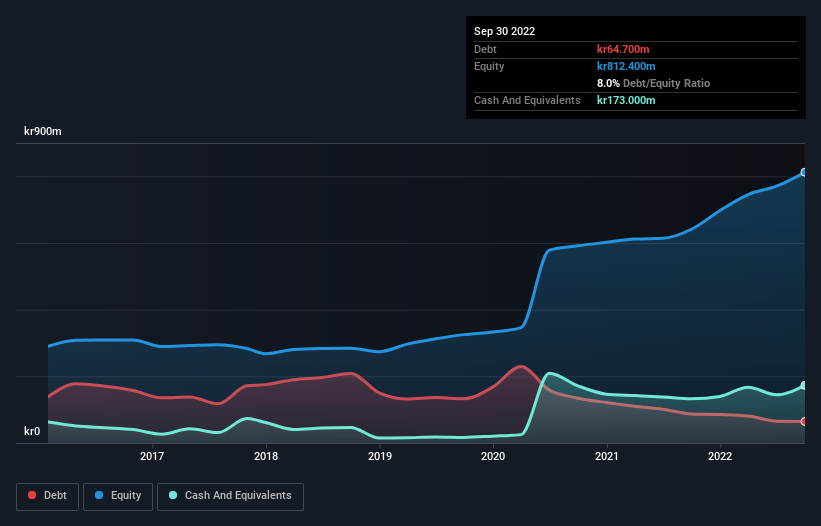The external fund manager backed by Berkshire Hathaway's Charlie Munger, Li Lu, makes no bones about it when he says 'The biggest investment risk is not the volatility of prices, but whether you will suffer a permanent loss of capital.' So it might be obvious that you need to consider debt, when you think about how risky any given stock is, because too much debt can sink a company. As with many other companies MedCap AB (publ) (STO:MCAP) makes use of debt. But the more important question is: how much risk is that debt creating?
Why Does Debt Bring Risk?
Debt is a tool to help businesses grow, but if a business is incapable of paying off its lenders, then it exists at their mercy. If things get really bad, the lenders can take control of the business. However, a more frequent (but still costly) occurrence is where a company must issue shares at bargain-basement prices, permanently diluting shareholders, just to shore up its balance sheet. Of course, the upside of debt is that it often represents cheap capital, especially when it replaces dilution in a company with the ability to reinvest at high rates of return. When we examine debt levels, we first consider both cash and debt levels, together.
View our latest analysis for MedCap
What Is MedCap's Net Debt?
You can click the graphic below for the historical numbers, but it shows that MedCap had kr64.7m of debt in September 2022, down from kr87.0m, one year before. However, its balance sheet shows it holds kr173.0m in cash, so it actually has kr108.3m net cash.

How Strong Is MedCap's Balance Sheet?
We can see from the most recent balance sheet that MedCap had liabilities of kr230.2m falling due within a year, and liabilities of kr179.0m due beyond that. Offsetting these obligations, it had cash of kr173.0m as well as receivables valued at kr194.4m due within 12 months. So its liabilities total kr41.8m more than the combination of its cash and short-term receivables.
Having regard to MedCap's size, it seems that its liquid assets are well balanced with its total liabilities. So it's very unlikely that the kr3.11b company is short on cash, but still worth keeping an eye on the balance sheet. Despite its noteworthy liabilities, MedCap boasts net cash, so it's fair to say it does not have a heavy debt load!
In addition to that, we're happy to report that MedCap has boosted its EBIT by 47%, thus reducing the spectre of future debt repayments. When analysing debt levels, the balance sheet is the obvious place to start. But it is MedCap's earnings that will influence how the balance sheet holds up in the future. So if you're keen to discover more about its earnings, it might be worth checking out this graph of its long term earnings trend.
Finally, while the tax-man may adore accounting profits, lenders only accept cold hard cash. MedCap may have net cash on the balance sheet, but it is still interesting to look at how well the business converts its earnings before interest and tax (EBIT) to free cash flow, because that will influence both its need for, and its capacity to manage debt. During the last three years, MedCap generated free cash flow amounting to a very robust 83% of its EBIT, more than we'd expect. That positions it well to pay down debt if desirable to do so.
Summing Up
While it is always sensible to look at a company's total liabilities, it is very reassuring that MedCap has kr108.3m in net cash. The cherry on top was that in converted 83% of that EBIT to free cash flow, bringing in kr100m. So we don't think MedCap's use of debt is risky. We'd be very excited to see if MedCap insiders have been snapping up shares. If you are too, then click on this link right now to take a (free) peek at our list of reported insider transactions.
At the end of the day, it's often better to focus on companies that are free from net debt. You can access our special list of such companies (all with a track record of profit growth). It's free.
New: Manage All Your Stock Portfolios in One Place
We've created the ultimate portfolio companion for stock investors, and it's free.
• Connect an unlimited number of Portfolios and see your total in one currency
• Be alerted to new Warning Signs or Risks via email or mobile
• Track the Fair Value of your stocks
Have feedback on this article? Concerned about the content? Get in touch with us directly. Alternatively, email editorial-team (at) simplywallst.com.
This article by Simply Wall St is general in nature. We provide commentary based on historical data and analyst forecasts only using an unbiased methodology and our articles are not intended to be financial advice. It does not constitute a recommendation to buy or sell any stock, and does not take account of your objectives, or your financial situation. We aim to bring you long-term focused analysis driven by fundamental data. Note that our analysis may not factor in the latest price-sensitive company announcements or qualitative material. Simply Wall St has no position in any stocks mentioned.
About OM:MCAP
MedCap
A private equity firm specializing in investments in secondary direct, later stage, industry consolidation, add-on acquisitions, growth capital, middle market, mature, turnarounds, buyout.
Flawless balance sheet and slightly overvalued.
Market Insights
Community Narratives




